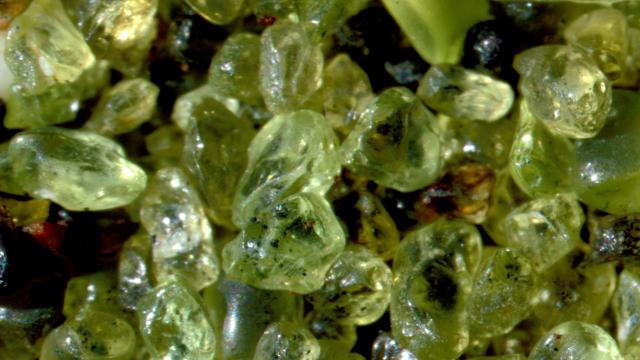Physicists typically build large, complex experiments to hunt for dark matter particles coming from outer space, but what if clues to its existence have been hiding inside the Earth all along? One group of physicists proposes hunting for signs of it in ancient minerals, such as olivine or gypsum, that formed in the Earth’s mantle or in seawater.
Experiments suggest that five-sixths of the universe’s mass is dark matter, mysterious stuff that acts like scaffolding for galaxies but which can only be observed via the gravity it exerts. Searches around the world have turned up empty-handed, with one much-contested exception. Now, scientists are preparing to hunt for signatures of dark matter particles in the Earth itself.
It might sound a little farfetched—but this strategy has some advantages over some current dark matter searches, which rely on massive, expensive, custom-built facilities. “We’re not going to build anything,” study author Katherine Freese, theoretical astrophysicist and professor at the University of Michigan, told Gizmodo. “That’s the beauty of it all.”
Dark matter appears to fill the universe based on observations of how galaxies rotate and arrange themselves in space, and appears to have caused slight temperature variations in the most distant light that reaches Earth. Dark matter detectors largely operate on the same principle: If there’s as much dark matter as astronomical observations imply, then we should just build an super-sensitive detector deep underground and wait, hoping that a dark matter particle will eventually create a signal. Detector materials include liquid xenon, sodium crystals, and ultra-cold germanium.
But the largest of these experiments have failed to find evidence of dark matter—instead, they’ve found a number of properties that dark matter doesn’t have, with the hope of eventually revealing the properties that it does have.
Ancient minerals present a new opportunity to expand the search using billion-year-old paleo-detectors — things like olivine, a greenish mineral formed from crystallised magma, and gypsum, a soft mineral that forms from evaporated water — that might retain evidence of interactions with passing dark matter particles.
A dark matter particle that weakly interacts with matter could nudge some of the atoms in the mineral, leaving behind 500-nanometre-long damage tracks that could be detectable in the rock after perhaps a billion years or longer, according to the paper published in Physical Review D. The researchers would hunt for these minerals and analyse them for the signature tracks using state-of-the-art microscopes.
The newest paper builds on 35-year-old work from physicists like Buford Price, whose team looked for theorised single-pole magnets in 460-million-year-old mica, as well as more recent passive detector attempts. Freese and the new paper’s authors hope that new technology will make their strategy more successful. “There are now detectors with nanometre resolution, so you get a lot more information than you would back in those days.”
Better resolution is important because the rocks could record more than just dark matter tracks — they may also store etchings from radioactive uranium stored in the material. The researchers need to fully understand how much of a background they’ll see from the uranium. They’re also hoping to analyse rocks formed in the Earth’s mantle or in sea water where concentrations of uranium are lower, or to look at rocks containing high levels of hydrogen, which would reduce tracks produced by neutrons.
This research is just a proposal and requires feasibility studies and tests on the minerals that the scientists propose using, according to the paper. But they could offer advantages over other experiments, since they might reveal whether the amount of dark matter hitting the Earth varies over time, and might even be useful for applications beyond dark matter, like studying tiny particles that emanate from the Sun and distant exploding stars called neutrinos, Freese told Gizmodo. And of course, there’s always the chance that no amount of hunting will reveal any such particles if scientists are wrong about the nature of dark matter.
Is the Earth hiding the secrets of dark matter etched into its ancient minerals? It will take drilling and testing before scientists can answer that question—but I suppose it’s easier than sticking a vat of liquid xenon deep underground.
